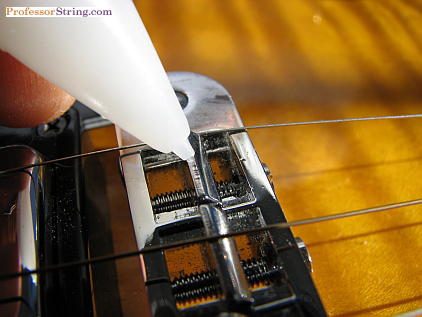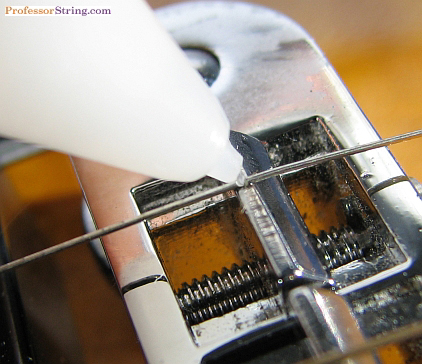
by Professor String


by Professor String |
Are your guitar strings breaking at the wrong time? Here are the fixes… |
|
So you are in the middle of playing one of your favorite tunes with your band at
a gig. Your solo is coming up, and it is going to be super cool and awesome. The
first measure of your solo begins, and then *POP!* your second note vaporizes
into thin air with no sound. You look down at your hand. What do you see? Argh!
A busted E string! To salvage the solo, you will have to do some quick thinking
and some improvisation with the five remaining strings. Does this sound
familiar? Why does this happen? This is truly a frustrating moment for many
players, regardless of skill level. Anytime a string breaks, it is unannounced,
and an unwelcome surprise. String breakage is unpredictable. A newer set can
give us some confidence that the strings are fairly fresh, but there is still no
guarantee. For the guitarist who likes to bend a super thin E string several
steps, breakage is a part of life. For the bassist who slaps and pops the
strings all the time, breakage is simply a part of life.
FACT: All strings eventually break.
Have you ever noticed where the string actually breaks? It can be almost
anywhere. Sometimes it breaks in the middle.
Sometimes it breaks at the nut.
Sometimes it breaks at the ball end.
Sometimes it breaks right at the bridge.
Knowing where strings typically break can provide some valuable insight in
getting string reliability to improve on your instrument. Let’s take a look at
some common metal string breakage points and the solutions that can increase
string reliability.
Bridge Breaks
For those of you who have the Tune-o-matic style of bridge, you may have noticed
the string tends to break at the saddle. There is a small sliding action that is
caused across the saddle whenever the string is bent, and stretches during
playing. Some guitar technicians will file the tip of the saddle to make sure it
is not too sharp. If it is too sharp, the pressure point of the saddle will dig
into the string and cause breakage. The more superior designs have substituted
the saddle with a roller. The principle of the roller design is to have the
string roll over the pressure point rather than slide across it. However, if you
do not have the roller design, there are some other things that can be done to
prolong string life. There are some bridge manufacturers that offer a graphite
based saddles. The idea behind the graphite saddle is to provide a lower
friction surface for the string to move across. This will prevent the string
from scraping across the pressure point and wearing out to the point of
breakage. If you do not like the looks of the roller bridge, or the black
colored graphite saddle, there are still more options that do not affect string
tone. The original Tune-o-matic saddle can be tweaked to extend string life.
String lubrication can be a vital tool in prolonging string life. However, many
players, as well as technicians do not know how to apply it correctly. Many
folks apply the lube to the tip of the saddle and neglect the string as shown in
FIGURE 1. This is good. However, for optimum success with the lubrication, a
small amount must be applied to the string at the pressure point area of the
string after installation as shown in FIGURE 2. By lubricating both areas you
end up with the least amount of friction as possible across the saddle.
 Figure 1 |
 Figure 2 |
Mid-Neck Breaks
If you have found your strings breaking at mid-neck, there are certain measures
that can be taken to minimize the probability of this type of breakage. The
first stop of inspection should be at the frets. Many players worry about
strings eating away at the frets. Seldom does anyone worry about the frets
eating away at the strings. Of course this makes sense as strings are easier and
cheaper to replace than having a fret job done. However, we should not dismiss
the frets as being completely innocent. At this time, let’s state that not all
frets are created equal. A neck with bad frets will keep you changing strings
more times than you need. There needs to be a balance between fret quality and
string quality. A fret consists of a tang and a crown. The crown is where you
should focus and inspect. Different crown heights and widths are available. The
average acoustic guitar fret crown ranges from .080-.090 wide and are usually
around .050 tall. Most electric bass guitars are generally in the .100-.120
range. If the fret crowns have not been polished, then any abrasiveness in the
frets will wreak havoc on even the best strings. Also, narrower crowns tend to
wear out strings a little quicker as the force per unit area is more
concentrated at the fret-to-string contact area. String lubricants and polymer
coated strings can help, but they are merely band-aids rather than cures. In
either case you want to get to the root of the problem, which is the fret.
Getting the frets polished is a worth while effort to improve string life and
make playing a little easier. If the frets have not been beveled on the ends,
and your guitar does not have binding fret nubs, both top and bottom E strings
will suffer from extensive wear each time the string is rolled off beyond the
fret board area. The best solution is to get the fret ends filed and beveled. It
not recommended that you try doing the beveling or polishing yourself. Shop
around a find a good guitar technician that can do fret board work. Ask to see
samples of their work before you reach a final decision.
Nut Breaks
It’s fairly rare to the have the string break at the nut if the nut is made of
bone, composite, or plastic. These nut materials are soft and are string
friendly. Some of you with guitars having a metal nut can experience string
problems similar to the Tune-o-matic bridge issues. In this situation, you will
want to follow similar preventative measures as mentioned earlier. There is an
exception with regards to filing. Excessive filing on the nut will have an
impact on string height and action. Again, a good guitar technician can de-burr
and eliminate knife edges within the metal nut.
Ball End Breaks
Sometimes a string can break at the ball end. Why do strings break at the ball
end? The answer to this question has more to do with the manufacturing process
of a string. Without going into detail, the ball end represents a stress point
in which the metal is bent at a sharp radius around the metal barrel. In short,
where there is stress, there is weakness. The bullet end string design that was
done by Fender years ago was a design that addressed some of the short comings
of barrel end termination. As a player there is not much that can be done to
minimize ball end breaks. Luckily, the ball end is typically not an area
subjected to wear with most bridge designs.
Finally…
Hopefully, the breakage issues that we covered gave you further insight to
improving the reliability of your instrument. Whatever brand of strings you
play, having an instrument that is well prepared for string installation will
greatly improve performance.
Do you have some thoughts about this article or the subject? Share it with everyone on the Professor's Forum.
|